Greetings friends, I hope you are doing well, and thanks for stopping by to visit.
Given we are well into the Holiday Season, let me wish you all a Happy Holidays as well!
This article's focus is on a 'first listen' of sorts, to the impressive Audio Note (UK) CD 4.1x Level 3 Red Book CD player ($14,331 USD) that just arrived HERE at Jeff's Place, along with a little bit of an 'adventure voicing' discussion as I work towards optimizing the performance of the CD 4.1x in my audio system for my listening preferences.
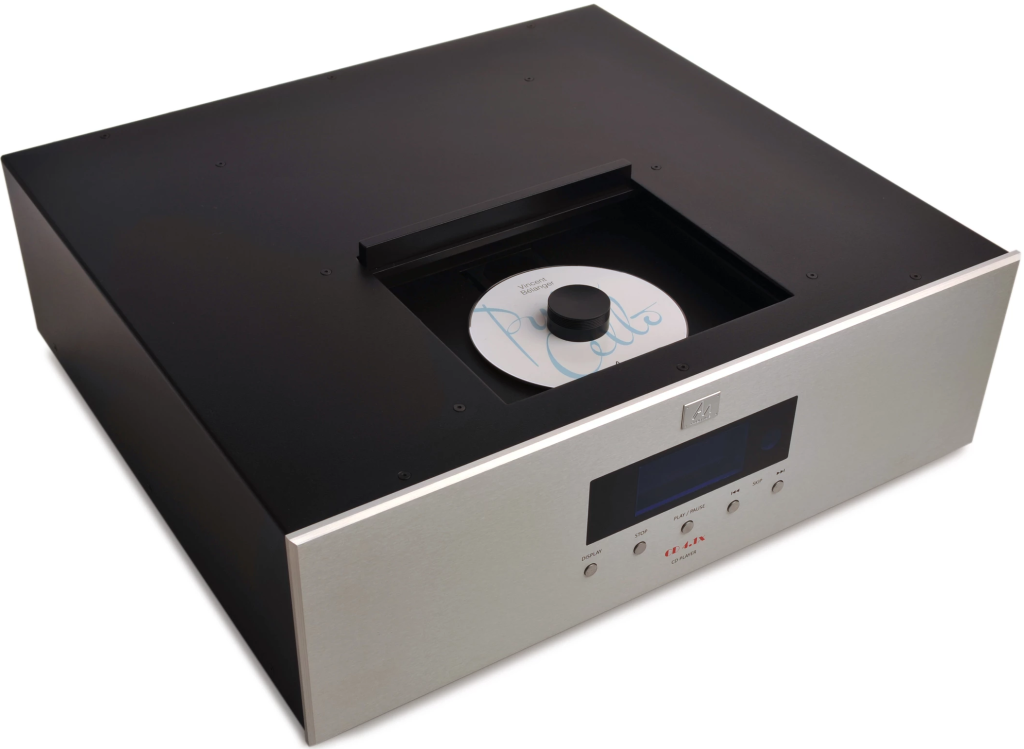
Audio Note (UK) CD 4.1x CD player ($14,331 USD).
This particular CD 4.1x is a well-traveled demo unit, so it was already completely run-in upon its arrival here at Jeff's Place.
That's an unexpected luxury for me, as it means I don't have to put the CD 4.1x through the usual 200 or so hours of playing time recommended in the owner's manual for getting a new CD 4.1x properly run-in, to be able to hear what it is all about performance-wise.
The CD 4.1x was ready for listening upon arrival!
Scene One
Allow me to set the stage for what you will read in the following paragraphs of listening impressions. In the process of gathering my 'first listen' impressions of the CD 4.1x, I am at the same time engaging in my 'adventure voicing' process to optimize the performance of the CD 4.1x in my audio system for my listening preferences.
What is my 'adventure voicing' process, you ask?
It's an iterative voicing process whose focus is achieving the best overall audio system voicing across the broadest range of music possible, inclusive of all the historic eras of the recording arts: the acoustic era (1877 to 1925), the electric era (1925 to 1945), the magnetic era (1945 to 1975), and the digital era (1975 to present), so that the final system voicing allows for maximum high-fidelity listening adventures for all recorded performances of music ever made.
We have an enormous cultural heritage in our recorded music canon that is as sacred to me as our literature canon from Shakespeare, Thoreau, or Rexroth, for example, and of course the many other literary deities that have walked Planet Earth.
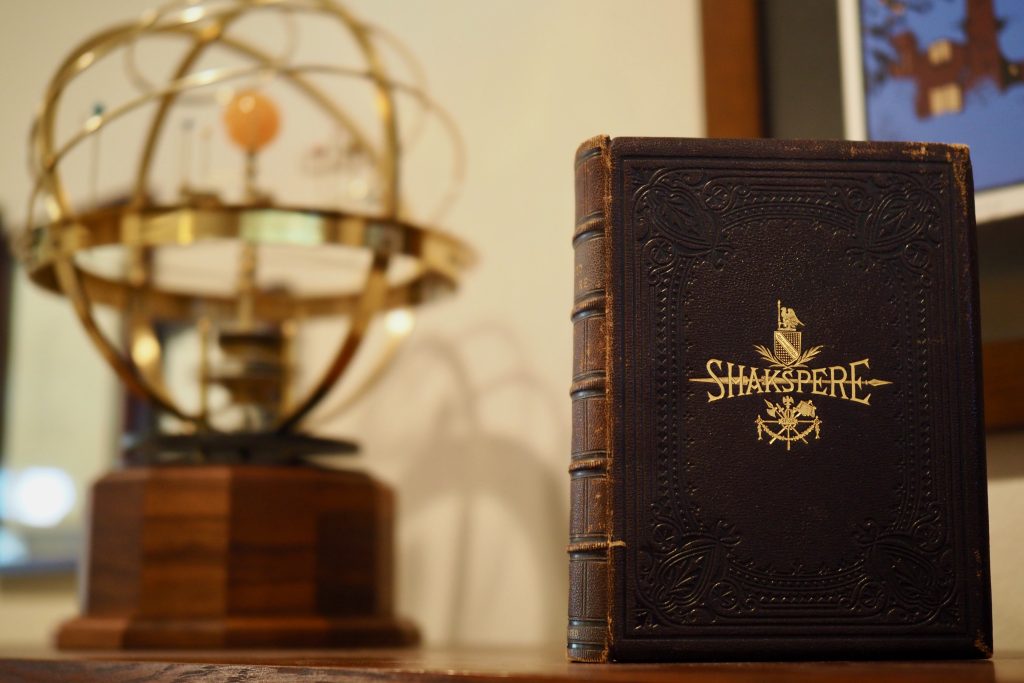
The illustrated "Leopold Shakspere" collection.
Take my vintage illustrated "Leopold Shakspere" volume that contains all of William Shakespeare's writings in chronological order, as an example (thank you, Cindy). This volume contains the touching inscription inside the cover, "To Louisa from Will, Christmas 1875", which is a scant two years before the dawn of the acoustic era of recording in 1877.
I would never consider not reading one of the great works of literature because it came from earlier days of publishing, which might make it a little more challenging to read. Yet that commonly occurs with audio enthusiasts who forsake listening to music performances recorded early in the acoustic or electric eras of the recording arts.
Can you imagine not listening to the performances of Enrico Caruso, one of the greatest operatic tenors of all time, because he was recorded in the acoustic era of the recording arts? Can you imagine not listening to Fred Astaire's Cheek to Cheek or the Carter Family's Can The Circle Be Unbroken because they were recorded in the 1935 during the electric era of recording?
In audio, this oversight is mostly due to misinformation, as many audio enthusiasts aren't really aware that there are incredible musical performances that span the four eras of the recording arts (1877 to today), and that quite a lot of the greatest musical performances ever recorded fall into those early acoustic (1877 to 1925) and electric eras (1925 to 1945) of recording.
A well-rounded audio enthusiast will want to be able to explore and listen to all of the great performances our recorded music canon has to offer, in the highest fidelity possible for their era of recording.
More than once I've raved about how great the musical performances are on a particular album from one of the early recording eras, and a reader bought it based on my enthusiasm for it, listened to it, then contacted me to tell me how terrible it 'sounded' on their audio system.
Guess what? It wasn't that album of musical performances that was at fault, rather it was a poorly voiced (or designed) audio system at fault, which is what the 'adventure voicing' process is intended to address.
There is a vast amount of listening adventures to be had with music from all eras of our recorded music canon, and the idea of 'adventure voicing' is to open up all those eras so those great musical performances that have been documented and preserved for music lovers in the past, the present, and the future, can be enjoyed by a listener today in the highest fidelity possible regardless of the recording era or recording quality.
To start my 'adventure voicing' process, I just dive right in and start listening to albums. A jazz album from the magnetic era cherished by audiophiles. An album by Caruso from early in the acoustic era cherished by opera lovers. A rock & roll album from the magnetic era with poor fidelity but great music. An album from the electric era with great classical music, but is a bit noisy. An album by the Carter Family or Fred Astaire in 1935 in the middle of the electric era ... well you get the idea ... any album I feel like listening to.
I consider what I hear and feel from the recordings, and then start iteratively optimizing component / system voicing as I listen to more and more albums from the different eras of recording until I achieve a final voicing that provides the highest possible fidelity across the four eras of the recording arts, and the varied recording quality that is present in each of the recording eras.
Scene Two
Let me start with an example of listening and 'adventure voicing' with friend and jazz guitarist, David Gitlen, who comes by to teach me a jazz guitar lesson each week, after which we convene to my living room to listen to jazz guitarist CDs while sipping a few espressos.
This has become a weekly tradition for David and I, and is a lot of fun. David randomly picks out CDs of great jazz guitarist performances from his collection, with a focus on the quality and/or uniqueness of the musical performance by the featured jazz guitarist.
We listen to what's going on in the music from a jazz guitarist's perspective on the guitarist's musical technique as recorded on the album (David), what's going on in the recording from a recording arts perspective (both David and I), and we consider how well the performance of the audio equipment is relaying all of that to both of us in our listening session. It's a lot of fun, and a great learning experience!

Jim Hall & Red Mitchell live at Sweet Basil in 1978 - Valse Hot.
Some time ago I told you a story about David and I listening to the Jim Hall & Red Mitchell album recorded live at the Sweet Basil bar & restaurant jazz club in 1978, Valse Hot.
We were listening to Valse Hot on my Tannoy Westminster Royal SE loudspeakers based system, with the award winning Triode Lab 45 EVO SET integrated amp providing the amplification (more HERE), and the impressive - and also award winning - Audio Note (UK) CD 2.1x/II CD player that has so enthralled me over the last year (more HERE).
Duelund DCA16GA tinned-copper speaker cables connected the 45 EVO SET to the Westminsters, and Duelund Dual DCA16GA tinned-copper interconnects connected the CD 2.1x/II to the 45 EVO SET. The power cord for the CD 2.1x was Mark Coles' Sablon Audio brilliant Gran Corona, and the power cord for the 45 EVO SET was an exotic Acoustic Revive Absolute.
That was the final 'adventure voicing' configuration for this particular combination of components, a simple super-system, which has provided the highest-fidelity sound quality I've ever heard from digital on my Westminsters, and the system was voiced to provide high-fidelity listening experiences on any album from any recording era.
Back to Valse Hot. David had studied jazz guitar with Jim Hall (and other jazz luminaries), and he was at Sweet Basil when Valse Hot was recorded.
As David and I were listening to Valse Hot he told me, "That's exactly what it sounded like when I was at Sweet Basil listening to Jim and Red play jazz those two evenings in January of 1978."
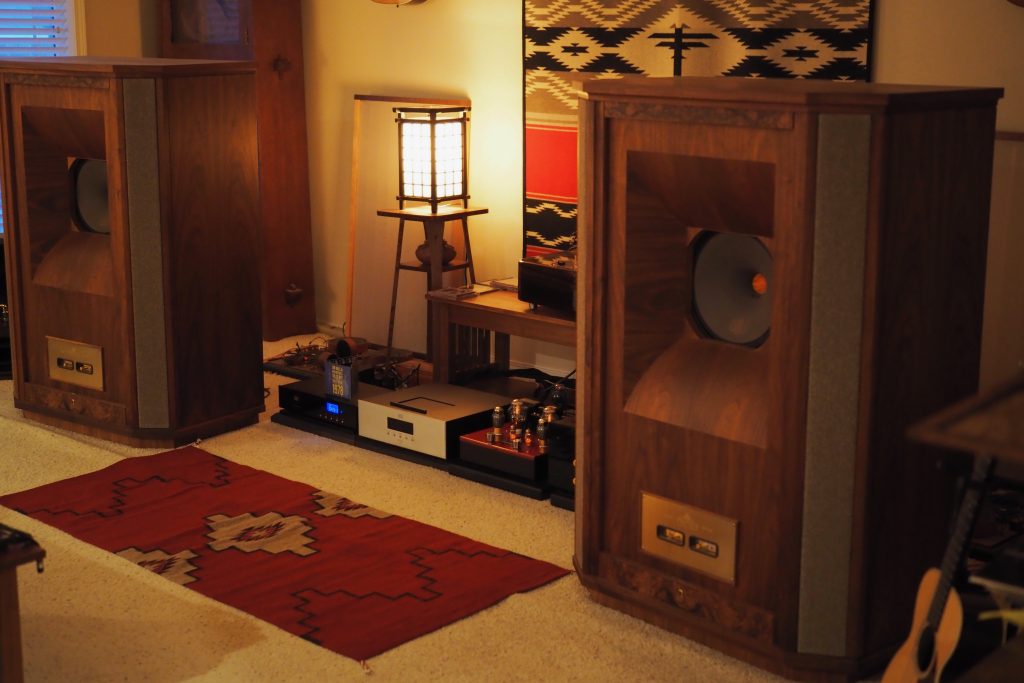
System photo December 4th 2021.
Scene Three
As I was writing this for you, can you guess what I was listening to? Valse Hot on the same system combination mentioned above, that David and I had previously listened to Valse Hot on.
I wasn't there for the recording sessions those two evenings in January like David was (I sure wish I was!), but I can tell you that it sounded and felt like I was sitting in a jazz club listening to one of the greatest jazz guitarists and bass players that have ever walked Planet Earth. Truly superb.
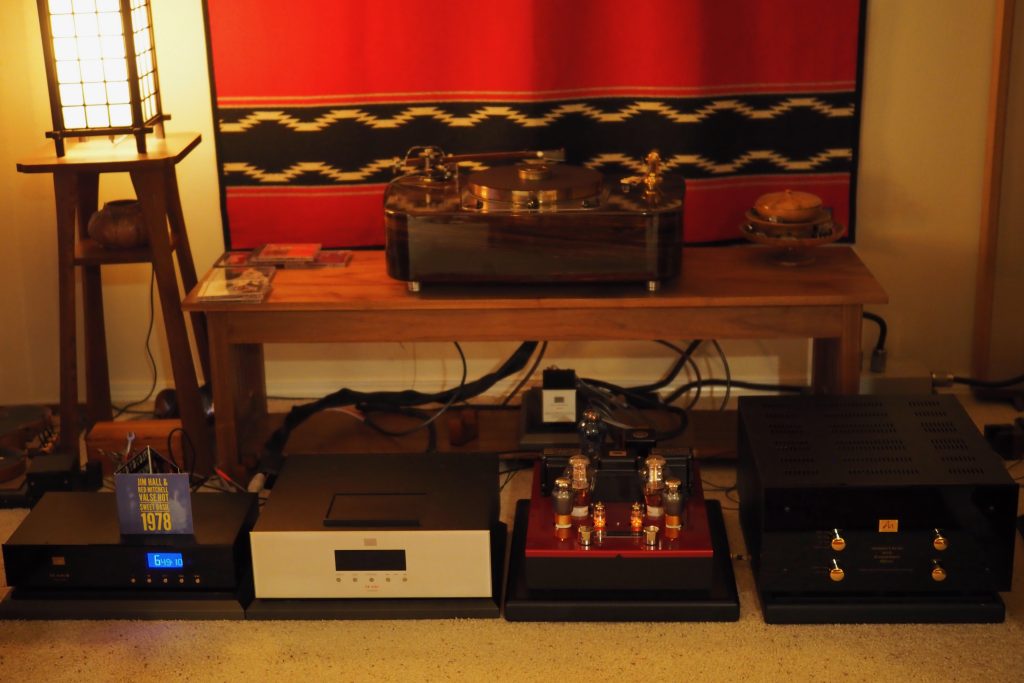
Left to right: CD 2.1x/II, CD 4.1x, 45 EVO SET, and Meishu 300B SET.
Valse Hot was recorded with a perspective like you would have heard at a table in Sweet Basil, with Jim and Red sitting about 9 feet from my 'table'.
I could hear all the nuance of Jim's guitar and Red's bass, and all those live sounds of the audience, much in the same way you can hear all the audience nuance in that old audiophile favorite, Jazz at the Pawnshop.
Valse Hot was just as mesmerizing and amazing when I listened to it while writing this as I remembered it to be when David and I previously listened to it with this same component context.
I wanted to listen to this equipment combination as a refresher and reference point, and then slip the Level 3 Audio Note (UK) CD 4.1x CD player into the system in place of the Level Two Audio Note (UK) CD 2.1x/II CD player.
Note: The Audio Note (UK) 300B Meishu Phono Silver Tonmeister Single-Ended-Triode integrated amplifier 'first listen' impressions will come at a future point, as the Meishu is still very early in its "bedding in" process, as Audio Note (UK) refers to it in the Meishu's owner's manual:
"The new amplifier requires about 200 hours of initial use (called “bedding in”) before the circuitry becomes stable and optimum performance is realized."
So it is way too early to say much about the Meishu, other than I like its design and what I'm hearing from it.
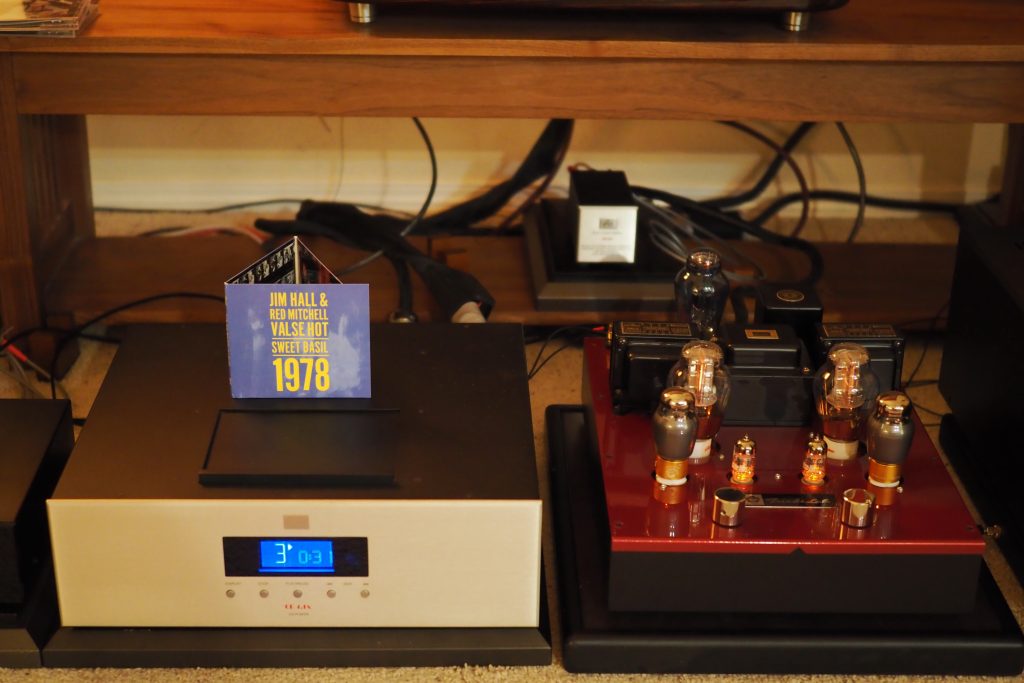
Audio Note (UK) CD 4.1x (left) and Triode Lab 45 EVO SET (right).
Scene Four
After putting the Audio Note (UK) CD 4.1x into the system in place of the CD 2.1x/II, and letting it warm up, I again listened to Valse Hot.
I heard quite a different overall presentation of the music on Valse Hot from the CD 4.1x than from the CD 2.1/II.
The first thing I heard was that even though both the CD 4.1x and the CD 2.1/II have a rated output of approximately 3.0V RMS, the CD 4.1x sounded much less loud at the same volume setting of the 45 EVO SET. I had to turn up the volume of the 45 EVO all the way up to get approximately the same volume level as I was getting with the CD 2.1x/II with the volume set at about 3/4's.
The second thing I heard was the CD 4.1x sounded warmer, richer, and darker than the CD 2.1x/II. There was also less sense of the ambient space in the Sweet Basil jazz club where Valse Hot was recorded.
Like the CD 2.1x/II, the CD 4.1x sounded beautifully musical, but it was bordering on a 'hot fudge sundae' style of presentation with its warmer, richer, and darker sound quality compared to the more neutral sounding CD 2.1x/II.
Just dropping the CD 4.1x into the system in place of the CD 2.1x/II didn't provide the level of performance improvement I was expecting to hear between a Level 3 vs. Level 2 Audio Note (UK) CD player, and in fact the CD 2.1x/II bested the CD 4.1x overall on Valse Hot.
Scene Five
Hint: This is where I start with my 'adventure voicing' process to get the maximum performance out of the CD 4.1x as a source component.
Generally, for a CD player, there are two things you can do to optimize its performance, and that is changing the power cord and/or changing the interconnects for those that are a more complementary performance match.
With the CD 4.1x there is also a third option of trying different vacuum tubes in its analogue output stage, which uses two ECC88 dual triode vacuum tubes. I'll stick with swapping in & out interconnects and power cords for now, but the temptation to do a little tube rolling at some point is strong upon me.
Generally when you get an unexpected performance result from a component there's some sort of equipment mismatch or malfunction occurring (or it's not adequately run-in, which is not the case with the CD 4.1x), so that meant I had some 'adventure voicing' work to do to see if I could coax out more of the CD 4.1x's full potential, as what was working so well for the CD 2.1x/II just wasn't working as well for the CD 4.1x.
I don't know if this a correct assumption - I'll have to ask Peter - but I suspect given the CD 4.1x's lofty second-from-the-top tier in the Audio Note (UK) CD player product line - that Audio Note (UK) silver interconnects are a preferable choice for the CD 4.1x, as silver tends to provide a brighter, more transparent, and more resolving presentation, which would be complimentary to the warmer, richer, and darker sound quality that I was hearing from the CD 4.1x.
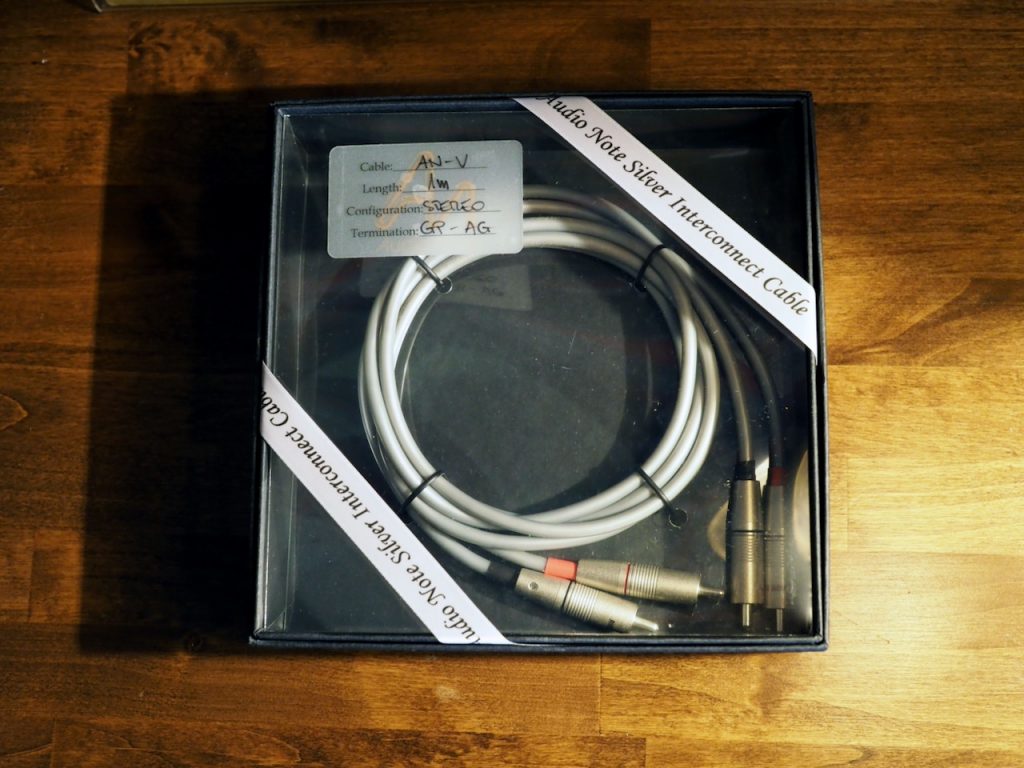
Audio Note (UK) AN-V silver interconnects.
I have several brands of silver interconnects here (Audio Note (UK), Duelund, and Sablon Audio) I can try, as well as silver-copper hybrid interconnects (Acoustic Revive), and of course the old recording studio favorites, the Belden 8402 tinned-copper microphone cable interconnects.
I also have a variety of 'super' power cords from Acoustic Revive and Sablon Audio, each of which have their own impressive performance characteristics in a particular context.
I decided I would cycle through the different interconnects I had available, then do the same thing with power cords, until I found the best combination for the voicing I was wanting to achieve.
It seemed sensible to start with the Audio Note (UK) AN-V silver interconnects, so I removed the Duelund Dual DCA16GA tinned-copper interconnects from the CD 4.1x, and hooked up the Audio Note (UK) AN-V silver interconnects that I normally use with the Audio Note (UK) Io I moving coil phonograph cartridge and AN-S4 step-up transformer combination for my CTC Garrard 301.
Then I listened to Valse Hot again. The Audio Note (UK) AN-V silver interconnects made a very positive difference in the overall presentation of the CD 4.1x, with its presentation now becoming more transparent, resolving, and natural sounding, rather than the warm, rich, and dark 'hot fudge sundae' presentation style the Duelund Dual DCA16GA interconnects were providing with the CD 4.1x.
I won't go into the details for each of the interconnects and power cords I tried, and instead cut I'll cut to the chase and tell you where I ended up with Valse Hot.
First of all, while the Audio Note (UK) AN-V silver interconnects sounded great with the CD 4.1x, they were a no-go if I wanted to listen to vinyl on my CTC Garrard 301 using the combination of the Audio Note (UK) Io I moving coil phonograph cartridge, the Audio Note (UK) AN-V silver interconnects, and the Audio Note (UK) AN-S4 step-up transformer combination, which I of course do, as that combination delivers 'out of this world' sound quality from vinyl records (more HERE).
Where I ended up for my preferred combination of the cable supporting cast were the exotic Acoustic Revive 'Absolute FM' silver-copper hybrid interconnects (HERE), the Acoustic Revive 'Absolute' power cable (HERE), and I also swapped out the Duelund DCA16GA speaker cables for the Audio Note (UK) AN-SPe silver loudspeaker cables.
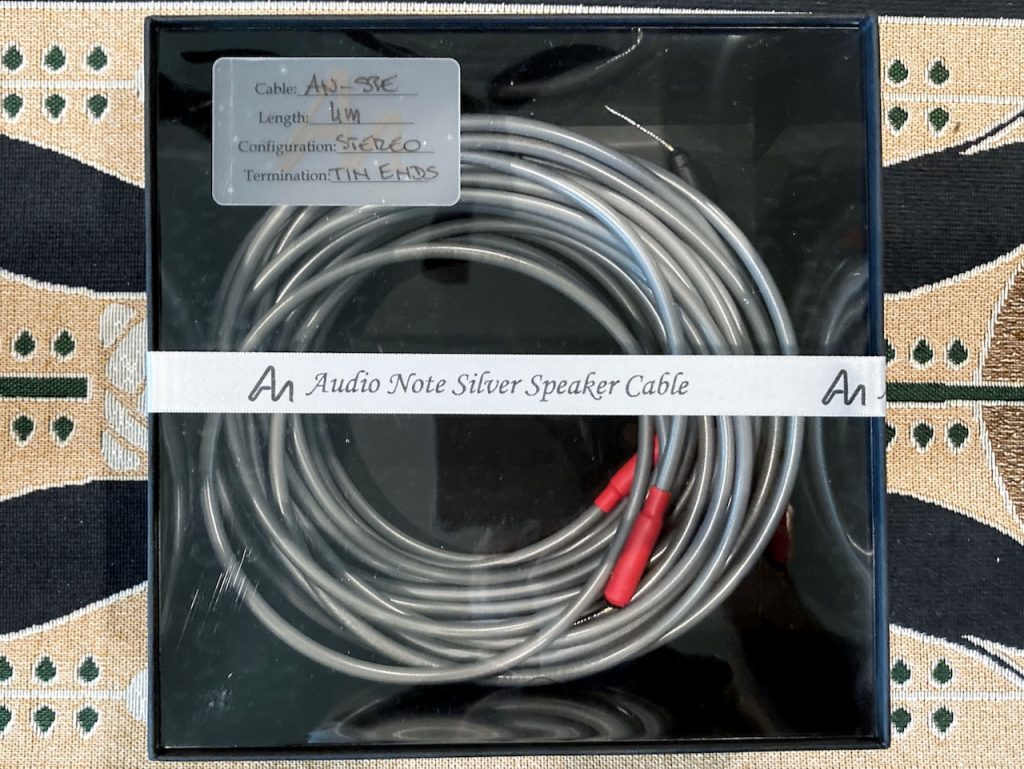
Audio Note (UK) AN-SPe silver loudspeaker cables.
That combination of interconnects, speaker cables, and power cable absolutely transformed the performance of the CD 4.1x, and it now outperformed the CD 2.1x/II significantly on Valse Hot, which is saying something, because I thought the CD 2.1x/II was/is rather awesome in its own right.
So now the CD 4.1x pretty much had everything in musical and sound quality terms displayed in its full glory on Valse Hot for my tastes, and truly excelling on that basic 'holy trinity' of superb tone, dynamics, and presence that makes music come alive in my listening/living room.
Denouement
Ok, so Valse Hot is an example of great music and a good quality recording on magnetic tape that has been transferred to digital, but that's just the first step in my 'adventure voicing' process.
Now I need to go through albums from the acoustic era of recording, the electric era of recording, more examples from the magnetic era of recording, and from the digital era of recording, in order to get my 'adventure voicing' fully optimized.
When I get to that point, I'll take a closer listen at a more nuanced level of timbral realism, the resolution of tone color, along with realistic portrayals of melody, harmony, rhythm, tempo, the entire spectrum of dynamics, and of course, how well the CD 4.21x does when playing music at live-like SPLs.
I'll provide more detailed commentary on the non-musical aspects of the CD 4.1x's performance that audiophiles find interesting, like transparency, resolution, soundstaging ability, imaging, and the CD 4.1x's ability to convey the acoustic sense of ‘space’ of the recording venue.
I'll comment on how well the CD 4.1x performs on an emotional engagement level, as well as its ability to present albums of recorded musical performances from all eras of the recording arts with a sense of 'authenticity' for the unique works of the musical & recording arts that they represent.
I'll also comment about comparing the performance of the Audio Note (UK) CD 4.1x to that of LP playback on my CTC Garrard 301 with the Audio Note (UK) AN-V silver interconnects, the Audio Note (UK) Io I moving coil phonograph cartridge, and the Audio Note (UK) AN-S4 step-up transformer combination.

Audio Note (UK) CD 4.1x Level 3 Red Book CD player ($14,331 USD).
As one final comment, I'll mention that I really have enjoyed the top-loading nature of the CD 4.1x. Placing a CD on the spindle, and placing the 'record' weight on the CD to secure it, reminds me a lot of putting an LP on my CTC Garrard 301's spindle, then adding a record weight. The CD 4.1x provides a very vinyl-like listening ritual for playing discs.
Ok, that's all for now, and there will be much more to come as I continue to get better acquainted with the Level 3 Audio Note (UK) CD 4.1x Red Book CD player.
As always, thanks for stopping by, and may the tone be with you!



























